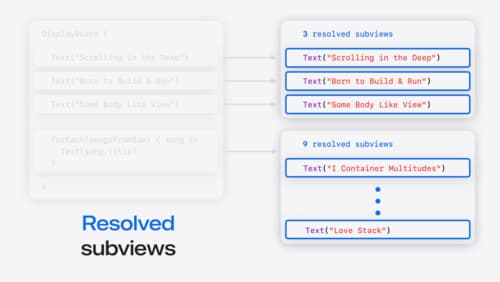What’s the best way to present a dynamic list of variable height cells using SwiftUI in a low performance device?
Asked on 2024-08-02
1 search
To present a dynamic list of variable height cells using SwiftUI on a low-performance device, you can leverage several techniques discussed in the WWDC sessions:
-
Dynamic Layouts: Use the dynamic type size environment keypath to adjust the layout based on the text size. For example, you can switch between
HStackandVStacklayouts depending on the accessibility size. This approach ensures that the layout adapts dynamically to provide more width to the text, making it easier to read while avoiding truncations. This technique is discussed in the session Get started with Dynamic Type. -
Composition and Containers: Utilize SwiftUI's built-in containers like
ListandSectionto organize your content efficiently. SwiftUI'sListcan be initialized with a collection of data or manually written views, and it supports sections for better organization. This is covered in the session Demystify SwiftUI containers. -
Lazy Grids: For more complex layouts, consider using
LazyVGridorLazyHGridto create grids that load content lazily, which can help with performance on low-end devices. This is particularly useful when dealing with a large number of items. This approach is demonstrated in the session Migrate your TVML app to SwiftUI. -
Optimizing Images and Icons: When working with images and icons, ensure they do not scale unnecessarily with text size to save space and improve performance. Prioritize scaling essential content over decorative views. This is discussed in the session Get started with Dynamic Type.
By combining these techniques, you can create a dynamic and responsive list that performs well even on low-performance devices. Here are the relevant sessions for further exploration:

Get started with HealthKit in visionOS
Discover how to use HealthKit to create experiences that take full advantage of the spatial canvas. Learn the capabilities of HealthKit on the platform, find out how to bring an existing iPadOS app to visionOS, and explore the special considerations governing HealthKit during a Guest User session. You’ll also learn ways to use SwiftUI, Swift Charts, and Swift concurrency to craft innovative experiences with HealthKit.

Get started with Dynamic Type
Dynamic Type lets people choose their preferred text size across the system and all of their apps. To help you get started supporting Dynamic Type, we’ll cover the fundamentals: How it works, how to find issues with scaling text in your app, and how to take practical steps using SwiftUI and UIKit to create a great Dynamic Type experience. We’ll also show how you can best use the Large Content Viewer to make navigation controls accessible to everyone.

Demystify SwiftUI containers
Learn about the capabilities of SwiftUI container views and build a mental model for how subviews are managed by their containers. Leverage new APIs to build your own custom containers, create modifiers to customize container content, and give your containers that extra polish that helps your apps stand out.
